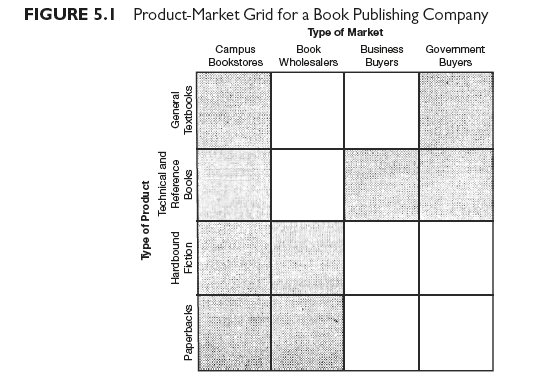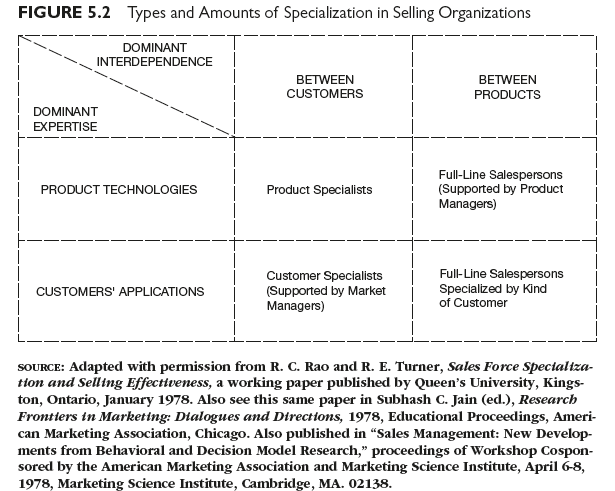One key decision on personal-selling strategy is that on the kind of sales personnel. Making this decision requires consideration of qualitative personal-selling objectives—what contributions toward the company’s longterm overall objectives should be expected from those performing selling jobs? What should be the duties and responsibilities of these individuals? How should their job performance be measured? Management must face up to these questions when it decides the kind of sales personnel it requires.
Each company has individualized requirements as to the kind of sales personnel best fitted to serve its needs. The reason goes beyond the fact that the qualitative personal-selling objectives of each company have some degree of distinctiveness. Each company deals with a unique set of marketing factors, such as the strengths and weaknesses of its products (what it sells), the motivations and buying practices of its customers and prospects (whom it sells to), its pricing strategy, and the competitive setting—the relative strengths and weaknesses of competitors. Furthermore, different sell-ing jobs require different levels of selling and nonselling abilities, training, and technical and other knowledge. The bottler’s driver-salesperson doing route selling has a considerably different job from that of the salesperson who sells complex industrial installations such as lathes and presses.
In determining the kind of sales personnel, then, we must understand what is expected of them: the job objectives, the duties and responsibilities, and the performance measures. Knowing the salesperson’s job means knowing the particular job for the particular salesperson—it is common for different salespersons in the same company to have quite different jobs. Knowing the particular job helps management to avoid “putting square pegs into round holes.” It helps in fitting the job to the person and the person to the job.
1. Product Market Analysis
No person is capable of selling all kinds of products to all kinds of customers. At one extreme, a salesperson sells a single product to many kinds of customers. At the other extreme, a salesperson sells a wide line of products to a single kind of customer. Most salespeople, however, have job assignments requiring them to sell some products to some kinds of customers. One way of categorizing selling jobs, then, is into three classifications: (1) product specialists, (2) market specialists, and (3) combinations of product and market specialization.
A critical step in sales job analysis is to define the nature of product-market interactions. It is advisable to construct a product-market grid (see Figure 5.1). Companies using product-market grids, of course, construct them showing much finer details of product-market interactions than that illustrated; this demands thorough analysis and classification of markets and products. The “boxes” indicate the different customers who might be sold the different products. As management decides which customers should be sold which products, some boxes are blacked in, others left empty. This helps to answer the question: Should our sales personnel be product specialists, iparket specialists, or a combination? Product specialization is indicated when the product is highly technical, requiring salespeople to advise on uses and applications. Market specialization is called for when the product is nontechnical but different kinds of customers have unique buying problems, require special sales approaches, or need special service. In many cases, analysis reveals that sales personnel need not only considerable knowledge of more than a single company product line and their applications but skills in dealing with more than one kind of customer.
Determining the type and amount of specialization requires consideration of both the interdependence dimension and the expertise dimension.

The four possible combination of these two dimensions (see Figure 5.2) results in four different kinds of selling roles.
If the dominant interdependence is between customers (rather than between products), sales personnel should be specialists. They should be product specialists when the needed dominant expertise is in product technologies. They should be customer specialists when the needed dominant expertise is in customers’ applications. Customer specialists need the support of market managers who provide the needed prospect expertise through their specialization in applications in particular industries.
If the dominant interdependence is between products (rather than between customers), the selling organization needs staffing by full-line salespersons. If product technologies require the most expertise, salespersons sell the full line to all kinds of prospects and are supported by product managers who provide the needed product expertise. If customers’ applications require the most expertise, salespersons sell the full line to particular kinds of prospects.
In addition to product-market interactions, other marketing elements affect the caliber of salesperson required. If most customers are large, for instance, salespeople need different talents as compared to if most customers are small. The geographical location of a territory has a bearing on the best type of salesperson, particularly where local prejudice favors “natives” as opposed to “outsiders.” If these or similar elements are important, appropriate grids assist in the analysis.

2. Analysis of Salesperson’s Role In Securing Orders
The role(s) that a company expects its sales personnel to play in securing orders influences the kind of sales staff required. All salespeople in some situations seek orders aggressively, but in others they need only take orders coming their way, the relative emphasis on order taking and order getting varying in different selling environments. The driver-salesperson for a soft drink bottling company is primarily an order taker, because the product has been strongly presold to consumers and retailers reorder automatically. The encyclopedia salesperson calling on householders most often functions as an order getter, since getting the order is the main goal.
Depending on whether promotional strategy places major reliance on personal selling or advertising, salespeople may be either active or passive forces in securing orders. If the promotional strategy of a manufacturer is to rely heavily upon advertising to attract business and build demand, marketing channels include several layers of intermediaries, and the role of the manufacturer’s salesperson is that of order taker primarily and order getter only incidentally. The opposite situation obtains when advertising is used mainly to back up personal selling—marketing channels contain a minimum number of layers of intermediaries, and the salesperson’s role is chiefly order getting.
There are cases both in consumer-goods and industrial-goods marketing in which the salesperson plays only a minor and indirect role in securing orders, the salesperson’s major role being concerned with other matters. In consumer-goods marketing, the missionary salesperson’s major role is to assist intermediaries in making sales to their customers. Orders from customers, then, result indirectly, rather than directly, from the missionary salesperson’s efforts. In industrial-goods marketing, the “sales engineer” plays two major roles: (1) advisor to intermediaries and customers on technical product features and applications and (2) design consultant to intermediaries and industrial users on installations or processes incorporating the manufacturer’s products. Sales engineers, then, also secure orders indirectly, rather than directly, and as the result of playing their major roles as advisors and design consultants.
3. Choice of Basic Selling Style
Differences in marketing factors cause each company to have individualized requirements as to the kind of salesperson it employs. These differences cause each company to expect its own sales staff to play somewhat unique roles (in some respects) even relative to companies employing “similar” kinds of sales personnel. Nevertheless, sales job roles can be grouped into four basic styles that cut, to a large degree, across industry and company boundaries: trade selling, missionary selling, technical selling, and new-business selling.[1]
Trade selling. The trade salesperson develops and maintains long-term relations with a stable group of customers. For the most part, this is low-key selling, with little or no pressure, and the job is dull and routine. This selling style, which predominates in marketing food and apparel and in whole-saling, applies primarily to products that have well-established markets. Advertising and other forms of promotion are more vital to overall marketing strategy than personal selling. One important responsibility of the trade salesperson is to help customers build up their volume through providing promotional assistance. For example, the salesperson for a line of breakfast cereals devotes much time to promotional work with retailers and whole- salers—taking inventory, refilling shelves, suggesting reorders, setting up displays, and the like.
Missionary selling. The missionary salesperson’s main job objective is to increase the company’s sales volume by assisting customers with their selling efforts. The missionary salesperson is concerned only incidentally with securing orders, since orders result from the missionary’s primary public relations and promotional efforts with customers of the customers (indirect customers). The missionary salesperson’s job is to persuade indirect customers to buy from the company’s direct customers. For example, the salesperson for a pharmaceutical manufacturer calls on the physician to acquaint the latter with a new product and to urge the him or her to prescribe the product to patients (indirect customers). Also, the missionary seeks to persuade pharmacists to buy from drug wholesalers, who are the direct customers. In some situations, missionary salespeople call on individuals and institutions who do not buy the product themselves but who influence its purchase. Missionary selling, like trade selling, is low key and does not require high-level technical training or ability.
Technical selling. The technical salesperson deals primarily with the company’s established accounts, and the main job objective is to increase their volume of purchase by providing technical advice and assistance. The technical salesperson performs advisory functions similar to those of the missionary salesperson but, in addition, sells direct to industrial users and other buyers. The technical salesperson devotes considerable time to acquainting industrial users with technical product characteristics and applications and to helping them design installations or processes that incorporate the company’s products. In this selling style, the ability to identify, analyze, and solve customers’ problems is important.
Technical salespeople often specialize, either by products or markets. In selling large made-to-order installations, such as steam turbines and electric generators, different technical salespersons work with different items in the product line. Other technical salespeople specialize in servicing either industrial accounts or government procurement agencies.
New-business selling. The new-business salesperson’s main job is to find and obtain new customers, that is, to convert prospects into customers. The salesperson specializing in new-business selling should be unusually creative and ingenious and possess a high degree of resourcefulness. Few companies, however, have sales personnel who do nothing but new-business selling; most firms expect their regular sales staff, who primarily do trade selling, to do new-business selling also. However, since it is rare for the same individual to possess both sets of required talents and because there is a tendency for salespeople to neglect new-business selling in favor of servicing established accounts, some experts advocate the specialization of sales personnel into two separate groups, one to concentrate on retaining existing accounts and the other to focus on converting prospects into customers.3
Source: Richard R. Still, Edward W. Cundliff, Normal A. P Govoni, Sandeep Puri (2017), Sales and Distribution Management: Decisions, Strategies, and Cases, Pearson; Sixth edition.

Hi my friend! I want to say that this post is awesome, nice written and include almost all important infos. I would like to peer extra posts like this .